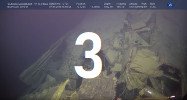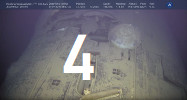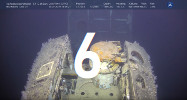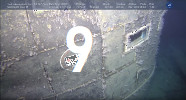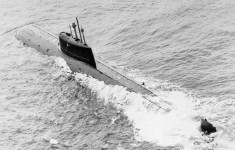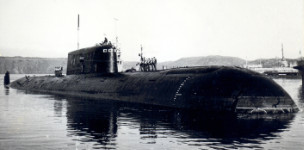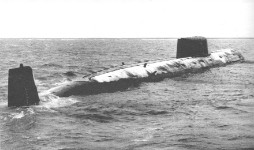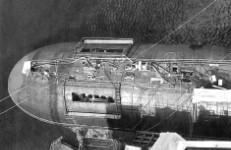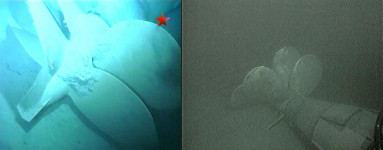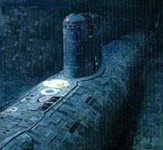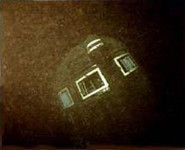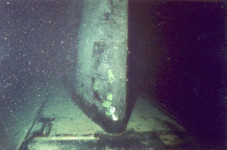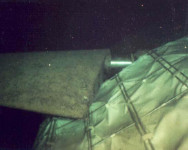Share: 


Wreck of Russia's unique deep-diving attack submarine K-278 Komsomolets
K-278 Komsomolets, Project 685 Plavnik ('Плавник') Class, NATO: MIKE Class
 The Ocean’s depths below 600 meters (1,970 ft) are almost exclusively the preserve of research submersibles and underwater engineering mini-subs. Almost. The Soviet Union did commission a nuclear-armed titanium-hulled attack submarine which could dive to 1,020 meters (3,350 feet), comparable to the US Navy’s famous unarmed NR-1. The submarine was lost on 7th April 1989 in the Norwegian Sea with the loss of 42 men.
The Ocean’s depths below 600 meters (1,970 ft) are almost exclusively the preserve of research submersibles and underwater engineering mini-subs. Almost. The Soviet Union did commission a nuclear-armed titanium-hulled attack submarine which could dive to 1,020 meters (3,350 feet), comparable to the US Navy’s famous unarmed NR-1. The submarine was lost on 7th April 1989 in the Norwegian Sea with the loss of 42 men.
The Norwegian Institute of Marine Research (Havforskningsinstituttet) published a video of the wreck on 8th July 2019 using footage from the Ægir 6000 Remote Operated Vehicle (ROV).
Original graphic. CLICK for high-resolution image:

Although NATO expected serial production, only a single prototype boat, K-278 Komsomolets, was built. She was rolled out of Sevmash's Workshop No. 42 on 30th May 1983 and launched on 3rd June 1983. Despite the incredible diving depth, the Pr.685 MIKE Class attack submarine had otherwise typical SSN performance.
Original artwork. CLICK for high-resolution image:

Pr.685 MIKE Class Specifications:
Displacement: 5,800 tons surfaced, 8,000 tons submerged
Length: 110 meters
Beam: 12.3 meters
Speed: 30 knots
Working Depth: 800 meters (normal operating)
Limiting Depth: 1,000 meters (Peacetime limit)
Collapse Depth: 1,500 meters (est)
Complement: 64 ordinarily
Armament: 6 x 533mm torpedo tubes; 22 torpedoes
Get The essential guide to World Submarines
This Covert Shores Recognition Guide Covers over 80 classes of submarines including all types currently in service with World Navies.Check it out on Amazon
The hull was made of Titanium alloy 48T which was lighter than steel so the same pressure hull weight fraction ('Group 1' hull weight) as on other boats was a stronger, allowing deeper diving. The deep-diving capability required some compromises. Although a large submarine at 5,800 tons, the MIKE Class was slightly smaller than other Russian third-generation attack submarines (AKULA Class, SIERRA Class), which allowed for just three decks and an older-generation Skat-Plavnik bow sonar. Because of the older sonar fit, it was sometimes referred to as a 2.5 generation boat. In fact, everything from the OK-650/OK-2A propulsion plant (with OK-650B-3 reactor) forward can be considered 2nd generation. The torpedo armament was 22 rounds which was better than many older submarines but compared to 30-40 rounds in contemporary Russian and US/UK attack submarines. And there was no towed array sonar.
The six 533mm (21”) torpedo tubes in the bow above the main sonar array. She carried SET-65 (ASW) torpedoes and SAET-60M (ASuW) torpedoes. It could also carry the rocket-powered VA-111 Shkval super-cavitating torpedo and, most likely, the RPK-2 Vyuga-53 (SS-N-15 STARFISH) depth charge carrying rocket. In order to minimize the number of openings into the pressure hull, the typical Russian torpedo loading hatch was abandoned and the torpedoes had to be loaded through the top two torpedo tubes (similar to some Russian diesel-electric submarines such as the KILO).

Learn EVERYTHING about Special Forces subs Covert Shores 2nd Edition. A world history of naval Special Forces, their missions and their specialist vehicles. SEALs, SBS, COMSUBIN, Sh-13, Spetsnaz, Kampfschwimmers, Commando Hubert, 4RR and many more.
Check it out on Amazon

Fate - 7th April 1989
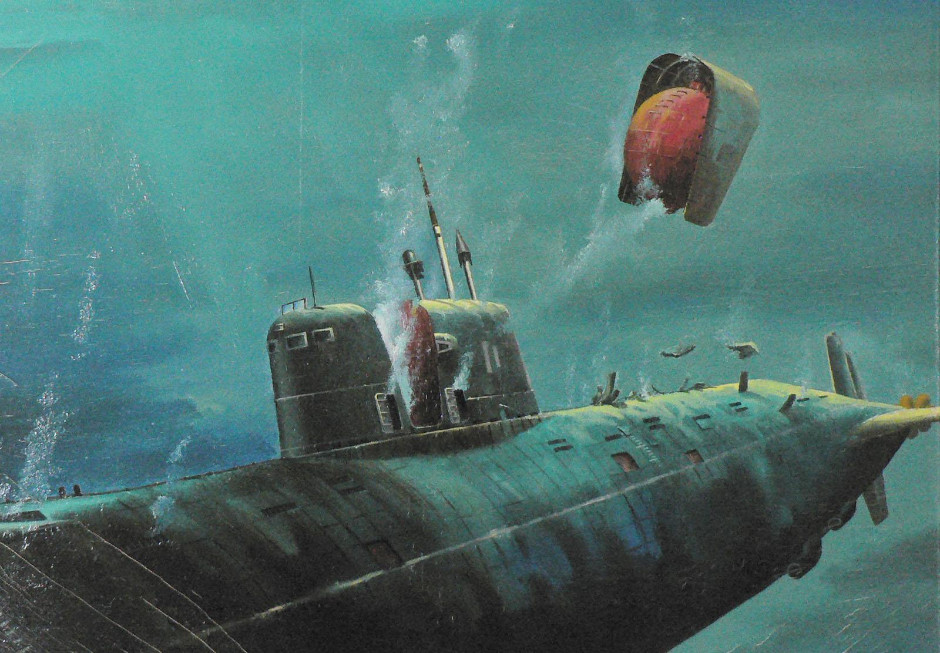
Incredible painting of escape capsule release during K-278 Komsomolets' sinking. Artist TBC.
On 7th April 1989 K-278_Komsomolets was cruising at a depth of 386 meters and 8 knots in International waters in the Norwegian Sea. At 10:55am power fluctuations were noticed throughout the boat. A fire supposedly started in one of the electrical panels in compartment seven (at the aft of the boat) that was experiencing a short. According to the official report, the panel either ignited leaked hydraulic fluid or oil vapors from a separator. Alternatively, it is suggested that the crew inadvertently created a high oxygen environment in compartment seven that enabled the electrical short to cause the fire. The fire burned very hot and soon was consuming compartment seven and leaking smoke into compartment six. The high-pressure air only leaked into compartment seven when the pipe feeding port MBT 10 ruptured after captain ordered the boat to surface.
By 11:13am the situation is dire and the submarine loses hydraulic power to the control surfaces. The captain, Captain First Rank Yevgeniy Vanin, orders main ballast tanks to be blown and the boat eventually rises to the surface where she floundered, awaiting rescue. The situation aboard was untenable and after a few hours the crew were evacuated. Thinking that surface help would arrive soon, the crew did not don wet suits even though the water is cold enough to kill them in 15 minutes.
Eventually efforts to keep the boat afloat start to fail and she started to sink at around 4:30 pm. At 4:42pm the Captain ordered the crew to abandon ship and minutes later sends his last radio message. Rafts are inflated from the boat and some are dropped by aircraft. Unfortunately many of the crew could not reach them in time and around fifty men are left in the frigid water. Six men, including the Captain, remained aboard as the boat finally sinks just after 5pm.
The six aboard the submarine manned the escape pod but one is accidently left behind in the thick smoke. The five remaining men released the pod and it rose to the surface as the submarine’s hull was crushed in the depths. When the hatch blew off, only one man was able to escape from the pod.In total, 42 of the 69 crewmen aboard perished.
An excellent write-up of the disaster can be found at the CIA Library.
Previous images of the wreck:
Related articles (Full index of popular Covert Shores articles)

 SIERRA-I Class SSN
SIERRA-I Class SSN

 SIERRA-II Class SSN
SIERRA-II Class SSN

 Project 885 'YASEN' (Severodvinsk Class) SSGN. w/Cutaway
Project 885 'YASEN' (Severodvinsk Class) SSGN. w/Cutaway

 Sturgeon Class SSN. w/Cutaway
Sturgeon Class SSN. w/Cutaway

 Project 955A 'BOREI-A' Ballistic Missile Submarine. w/Cutaway
Project 955A 'BOREI-A' Ballistic Missile Submarine. w/Cutaway

 Project 705 'ALFA' class attack submarine. w/Cutaway
Project 705 'ALFA' class attack submarine. w/Cutaway

 Project 673 Advanced Submarine design. w/Cutaway
Project 673 Advanced Submarine design. w/Cutaway

 Project 617 'WHALE' AIP Submarine
Project 617 'WHALE' AIP Submarine

 USS Grayback Special Forces host submarine
USS Grayback Special Forces host submarine

 NR-1
NR-1

 Sweden's nuclear powered submarine project (A-11A)
Sweden's nuclear powered submarine project (A-11A)

 USS Parche spy sub par-excellence. w/Cutaway
USS Parche spy sub par-excellence. w/Cutaway

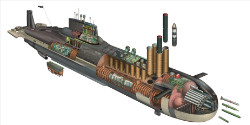 TYPHOON Class SSBN. w/Cutaway
TYPHOON Class SSBN. w/Cutaway

 Project 1910 UNIFORM Class deep diving spy sub
Project 1910 UNIFORM Class deep diving spy sub

 USS Halibut. w/Cutaway
USS Halibut. w/Cutaway

 USS Seawolf (SSN-575)
USS Seawolf (SSN-575)

 Russian X-RAY Class spy sub
Russian X-RAY Class spy sub

 Russian Sarov experimental sub
Russian Sarov experimental sub

 North Korean Modified-Romeo Class ballistic missile submarine
North Korean Modified-Romeo Class ballistic missile submarine



